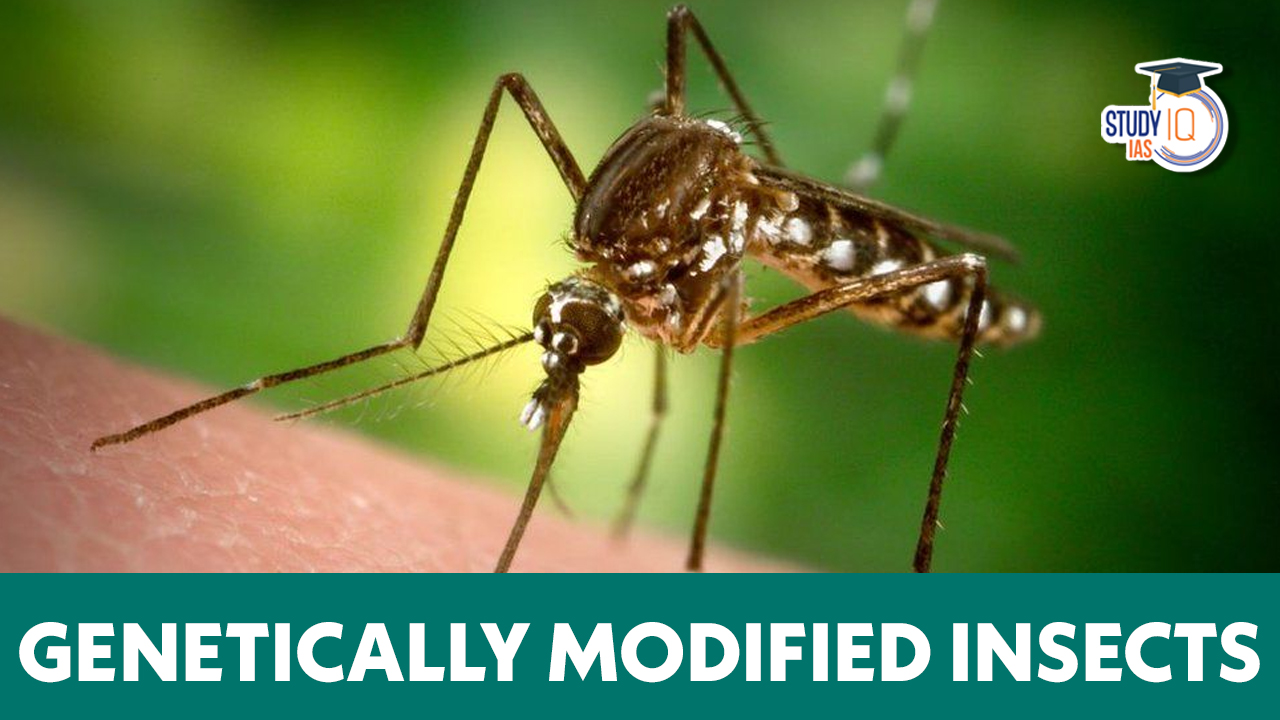Table of Contents
Context: Recently, the Department of Biotechnology (DBT) issued the ‘Guidelines for Genetically Engineered Insects’, which provide procedural roadmaps for those interested in creating GE insects.
What are Genetically Modified Insects?
- Genetically modified insects (GM insects) are insects that have been genetically engineered to have specific traits or characteristics through the manipulation of their DNA.
- GM insects are typically created by introducing foreign genes into the insect’s genome, altering its genetic makeup.
Techniques Used to Genetically Modify the Insects
- Insects are modified through three different ways mutagenesis, transgenesis and cisgenesis.
- Mutagenesis: it is a technique where DNA is mutated or deliberately engineered in a laboratory in order to produce libraries to include mutated genes, proteins and strains of bacteria or even other genetically modified organisms.
- Transgenesis: It is when a gene from another organism is placed into the genome of another organism in hopes that the organism will show a specific quality or characteristic.
- Cisgenesis: It is an engineering process where genes from one organism are artificially transferred to another closely-related or organism of the same species.
Potential Uses of GM Insects
- Crop pollination: Declining bee populations pose a threat to global food production, as bees play a crucial role in pollination. GM insects could be developed to enhance pollination in agricultural settings.
- For example, GM bees with increased pollination efficiency or resistance to certain pathogens could help sustain crop yields.
- Disease control: GM insects can be utilized to combat the spread of vector-borne diseases like malaria, dengue fever, or Zika virus.
- By modifying the insects in a way that renders them unable to transmit the disease-causing agents, researchers aim to reduce the incidence of these diseases.
- Pest control: GM insects can be designed to carry traits that make them effective in combating agricultural pests.
- For example, they can be engineered to produce offspring with reduced fertility, which can help in reducing pest populations.
- Environmental monitoring: Certain GM insects can be designed to act as environmental sensors, detecting and reporting the presence of specific chemicals or pollutants. They can be used to monitor air and water quality, detect landmines, or assess pesticide contamination.
- Genetic research: Genetically modified insects serve as valuable tools in studying gene function and understanding insect biology.
Concerns associated with GM Insects
- Unintended consequences: Modifying the genes of insects can have unpredictable effects such as increased resistance to control measures, genetic transfer to non-target species, or the emergence of more robust pests.
- Ecological impact: GM insects, when released into the environment, may interact with non-target species, potentially disrupting ecosystems.
- Gene flow and persistence: GM insects can potentially interbreed with wild populations, leading to the spread of the modified genes. This raises concerns about the persistence and spread of the genetically modified traits in natural populations.
- Ethical considerations: The use of GM insects may raise ethical concerns related to animal welfare and the alteration of natural systems.
- Entomological warfare: The potential use of GM insects in entomological warfare, also known as insect-based biological warfare, raises significant concerns.
- Targeted destruction: GM insects could be engineered to carry lethal pathogens or toxins and be deployed to attack crops, livestock, or humans.
- Enhanced vectors: GM insects could be modified to have increased vector competence, allowing them to transmit diseases more efficiently or to become resistant to control measures, posing a threat to public health.
- Over a decade ago, the United States Defence Advanced Research Project Agency (DARPA) was experimenting with “cyborg” insects, which would be remote controlled and additionally could be used as surveillance drones.
GM Insects across the globe
- Experimental releases of GM insects are reportedly being evaluated in various countries, including Brazil, the Cayman Islands (United Kingdom), France, Guatemala, India, Malaysia, Mexico, Panama, Philippines, Singapore, Thailand, the United States of America, and Vietnam.
- GM mosquitoes (Aedes aegypti) have already been released for field trials into inhabited areas in the Cayman Islands (2009), Malaysia (2010–2011), and Brazil (2011–2012).
- The world’s first environmental impact statement (EIS) on GM insects, produced by US authorities in 2008.
Concerns with the DBT’s Guidelines for Genetically Engineered (GE) Insects
- Lack of clarity on purpose: The guidelines do not explicitly state the purposes for which GE insects may be approved in India. While the guidelines mention potential applications in vector management, crop pest management, and other beneficial uses, there is uncertainty about the government’s vision for the use of GE insects in the broader bioeconomy.
- Uncertainty for researchers: The guidelines only apply to research and not confined trials or deployment. Once GE insects are created and tested in the laboratory, researchers need approval from the Genetic Engineering Appraisal Committee (GEAC) for conducting trials. However, the guidelines do not address the deployment of GE insects and the criteria for their approval by the Union Environment Ministry. The absence of clarity and criteria for deployment inhibits research investment and hinders wider community engagement and monitoring.
- Insufficient consideration of risks and misuse: The guidelines do not adequately address the potential risks and misuse of GE insect technology. The focus on risk groups rather than the product raises questions about the need for stringent checks for insects used in non-consumption purposes, such as silk or lac production. Additionally, there is a lack of clarity on addressing more dangerous possibilities and unintentional generation of malicious products, potentially leaving room for misuse or bioweapon concerns.


 Personality Rights in India: Expanding P...
Personality Rights in India: Expanding P...
 Judicial Recognition of Child Traffickin...
Judicial Recognition of Child Traffickin...
 Misrepresentation and Fraud in Digital T...
Misrepresentation and Fraud in Digital T...

























